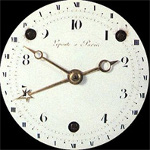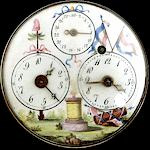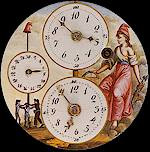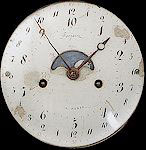-
Ever since man began using the sundial, the length of the day was divided into what we today call "hours". Already Babylonians and Egyptians used this system.
Greeks and Romans used the "temporal hours": the day and night were both divided into twelve parts, starting respectively from sunrise and sunset. So the first hour of the day corresponded to sunrise, the sixth hour more or less at noon, the twelfth hour at sunset and the same, starting from sunset, occurred for the night.Let’s make a temporal leap forward until the French Revolution which promoted the greatest attempts at rationalization in the human history; the most popular is the Metric Decimal System, which although many difficulties has survived until today becoming almost universal (only the United States and the Anglo-Saxon countries have not yet adopted it in full, although in use in the technical-scientific fields).
Towards the end of the 18th century, measurement chaos began to be put in order.
In 1790, the French Constituent Assembly established a special commission, which included the major physicists and mathematicians of the time, to determine a new unitary system of measurements.
In 1793, the Metric Decimal System was officially applied throughout France. The Metric Decimal System also included measuring time in a new mode, both of an average Solar Day and a Solar Year (revolutionary calendar).
While the division of the "Average Solar Day" was calculated and applied in:10 hours, every hour 100 minutes and every minute 100 seconds. This experiment of dividing the day into only 10 hours lasted a short time (not even a year), however, some examples of watches of the time have remained to witness this event, shown below in various forms with the dial divided into 10 hours daily.




-
The intention of the illustrious scholars who created the new Metric Decimal System was to refer to a unit drawn from nature. The fundamental unit chosen was the unit of length, the meter, defined as forty-millionth part of the meridian of the Earth.
From the meter the units of measurement of other sizes derived: for example, the square meter for the surfaces and the cubic meter for the volumes. The unit of measurement of the masses was also indirectly linked to the unit of length: it was decided, in fact, to define the unit of measurement of the weight of the unit mass: the gram equivalent to the weight of one cubic centimeter of pure water, at the temperature of 4 ° C.The Metric Decimal System has gradually spread all over the world and today it is adopted by the great majority of countries. Such a success is mainly due to the decimal characteristic of the system, and because the ratios between multiples and submultiples of the various Units of Measure are powers of 10, therefore making it easy and intuitive to calculate all equivalence calculations between multiples and submultiples of a Unit of Measure.
Much more laborious and less intuitive is instead the transformation from a unit to its multiples or submultiples into a non-decimal measuring system still used in many countries.
To facilitate enormously the cultural and commercial exchange between countries around the world, it would be desirable for everyone to speak the same language and use the same Units of Measure. Therefore, many meetings were held for the global success of the Metric Decimal System and over the years it has changed its name several times, depending on the Units of Measure that became part of this measurement system. For example, in 1946, upon the proposal of Giovanni Giorgi, the "Amper" Electricity Measurement Unit was introduced and for this reason it was called the Giorgi System.
Since 1961, on the other hand, this grouping of various Measures has been called the International System (SI) which today includes many Units of Measure: Meter, Gram, Liter, Second, Hom, Amper, Kelvin, Candle, Mole.To manage the International System of Units, three world organizations have been established that are still in place:
- La Conférence Gènerale des Poids et Mesures, (CGPM)
- Il Bureau International des Poids et Mesures, (BIPM)
- Il Comité International des Poids et Mesures, (CIPM)
The Conférence Gènerale meets in Paris every 4, 5 or 6 years. In 2002, the GFCM represented 51 member states and 10 other associate members. As of 1 August 2011, 55 members and 34 associated states are members.
The "second" is the TIME Unit of Measure and it’s included in the International System (SI), its multiples are sexagesimal based (minutes and hours) while its submultiples (tenths, hundredths, thousandths etc.) are based 10.
It is therefore in my interest to ensure that the equivalence of the multiples of the "second" is changed, equating them to its submultiples which are already expressed in base ten (10). It is desirable that the "Average calendar day" currently divided into 86,400 seconds, will be brought to the new division of 100,000 seconds with the following grouping: